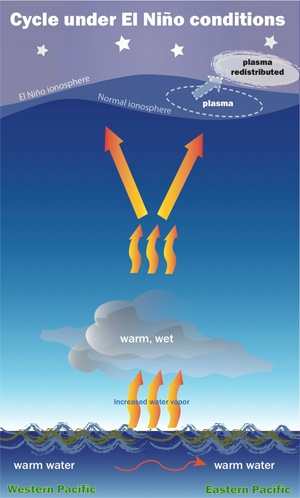El Niño has effects all the way to the edge of the atmosphere
18 Dec 2015
The warm El Niño conditions affecting weather around the Pacific Ocean are also affecting conditions in space, according to UC Berkeley scientists.
El Niño is commonly observed as a global change in rainfall due to changes in surface water temperatures in the southern Pacific Ocean. However, scientists at the University of California at Berkeley reported at the annual meeting of the American Geophysical Union in San Francisco that the processes that lead to increased precipitation are also driving unexpected changes in the ionosphere, the uppermost level of the atmosphere.
''We expected that we would see some changes in the ionosphere when we started this study, but we were shocked at how strong the effect has turned out to be,'' said Thomas Immel, a senior fellow at UC Berkeley's Space Sciences Laboratory. ''The connection between the lower and upper atmosphere has been getting more attention lately, largely because we keep discovering new ways in which the lower atmosphere affects the conditions higher up.''
The results, presented by Immel and based on calculations by Astrid Maute of the High Altitude Observatory in Boulder, Colorado, came from a study being conducted in advance of a new NASA mission, the Ionospheric Connection Explorer (ICON), which is being led by UC Berkeley and will study this and similar effects. ICON is currently scheduled for launch in the summer of 2017.
The researchers observed large enhancements in ionospheric density after dusk, a time when the ionosphere generally relaxes and is significantly thinner. This means that the ionosphere is disproportionately thick, even after sunset.
 El Niño
El Niño
According to Immel's UC Berkeley colleague Katelynn Greer, ''El Niño is the term used to describe abnormally high temperatures in the Pacific Ocean, which results in temporary changes in global weather patterns.
During El Niño, changes in wind and ocean current patterns result in warm waters stretching across the whole Pacific Ocean. This causes more water to vapourise into the atmosphere, which in turn will absorb more solar energy into the atmosphere. This extra heating causes changes in wind patterns, which causes atmosphere to react and change all the way from the ground to the edge of space around Earth.''
Although support for this effect is quite convincing, she said, the evidence currently consists exclusively of theoretical models. This is because there is no way to observe these kinds of changes in the ionosphere at the current time. The ICON satellite mission will directly observe and measure these ionospheric shifts.
''ICON will help us to understand what's happening in our own atmosphere, during El Niño and during normal conditions,'' said Immel, who is principal investigator for the mission. ''This is very exciting for us, since ICON will observe El Niño in the ionosphere for the first time ever.''







.webp)














